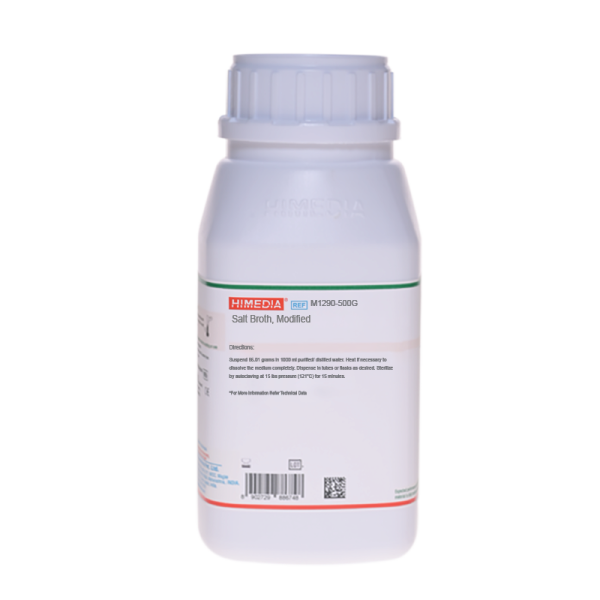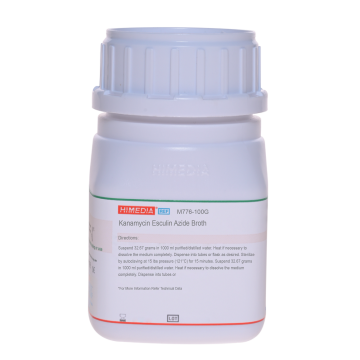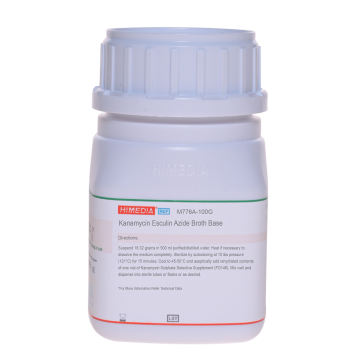 Your enquiry has been submitted
Your enquiry has been submitted
Salt Broth, Modified
MPN Test#CC293D
Intended Use:
Recommended an enrichment medium for the isolation of Staphylococci from grossly contaminated specimens.
Composition**
| Ingredients | g/L |
|---|---|
| Peptone | 10.000 |
| HI solids # | 10.000 |
| Dextrose (Glucose) | 1.000 |
| Sodium chloride | 65.000 |
| Bromocresol purple | 0.016 |
| Final pH (at 25°C) | 7.2±0.2 |
**Formula adjusted, standardized to suit performance parameters
# Equivalent to Heart infusion
Directions
Suspend 86.01 grams in 1000 ml purified/ distilled water. Heat if necessary to dissolve the medium completely. Dispense in tubes or flasks as desired. Sterilize by autoclaving at 15 lbs pressure (121°C) for 15 minutes.
Principle And Interpretation
Salt Broth, Modified is used for differentiating enterococcal group D streptococci from non-enterococcal group D streptococci. Medium containing 6.5% sodium chloride is used to differentiate Enterococci by determining salt tolerance of bile esculin positive and catalase negative cocci (1). High salt content of this medium acts as a differential and selective agent by interfering with membrane permeability and osmotic equilibrium (2). Enterococcal group D Streptococcus species (Enterococcus faecalis, Enterococcus faecium, Enterococcus durans and Enterococcus avium) can be easily differentiated from the non-enterococcal species like Streptococcus bovis, Streptococcus equines, by the 6.5% sodium chloride tolerance test. HI solids and peptone provide essential nitrogenous nutrients while glucose is the carbohydrate source in the medium. Bromocresol purple is the pH indicator which turns yellow from purple at acidic pH (1). Sodium chloride serves as differential and selective agent. Growth is indicated by turbidity and sometimes changes in colour of the indicator. A change in colour from purple to yellow also may occur due to utilization of glucose and thereby acid production. Serological group D streptococci or bile esculin positive isolate may be easily identified as an Enterococcus species.
Type of specimen
Isolated microorganisms from clinical samples.
Specimen Collection and Handling:
For clinical samples follow appropriate techniques for handling specimens as per established guidelines (3,4). After use, contaminated materials must be sterilized by autoclaving before discarding.
Warning and Precautions :
In Vitro diagnostic Use. For professional use only. Read the label before opening the container. Wear protective gloves/ protective clothing/eye protection/ face protection. Follow good microbiological lab practices while handling specimens and culture. Standard precautions as per established guidelines should be followed while handling clinical specimens. Safety guidelines may be referred in individual safety data sheets.
Limitations :
- Individual organisms differ in their growth requirement and may show variable growth patterns on the medium.
- Further biochemical and serological tests must be carried out for confirmation.
Performance and Evaluation
Performance of the medium is expected when used as per the direction on the label within the expiry period when stored at recommended temperature.
Quality Control
Appearance Cream to greenish yellow homogeneous free flowing powder
Colour and Clarity of prepared medium Purple coloured clear to slightly opalescent solution
Reaction Reaction of 8.6% w/v aqueous solution at 25°C. pH : 7.2±0.2
pH 7.00-7.40
Cultural Response
Cultural characteristics observed after an incubation at 35-37°C for 24-48 hours.
| Organism | Inoculum (CFU) | Growth |
|---|---|---|
| Streptococcus bovis ATCC 9809 | >=104 | inhibited |
| Enterococcus faecalis ATCC 29212 (00087*) | 50-100 | good |
Key: *Corresponding WDCM numbers.
Storage and Shelf Life
Store between 10-30°C in a tightly closed container and the prepared medium at 2-8°C. Use before expiry date on the label. On opening, product should be properly stored dry, after tightly capping the bottle in order to prevent lump formation due to the hygroscopic nature of the product. Improper storage of the product may lead to lump formation. Store in dry ventilated area protected from extremes of temperature and sources of ignition Seal the container tightly after use. Product performance is best if used within stated expiry period.
Disposal
User must ensure safe disposal by autoclaving and/or incineration of used or unusable preparations of this product. Follow established laboratory procedures in disposing of infectious materials and material that comes into contact with clinical sample must be decontaminated and disposed of in accordance with current laboratory techniques (3,4).
Reference
- Murray P. R., Baron J. H., Pfaller M. A., Jorgensen J. H. and Yolken R. H., (Ed.), 2003, Manual of Clinical Microbiology, 8th Ed., American Society for Microbiology, Washington, D.C.
- MacFaddin J. F., 1985, Media for Isolation-Cultivation-Identification- Maintenance of Medical Bacteria, Vol. 1, Williams Wilkins, Baltimore, Md.
- Isenberg, H.D. Clinical Microbiology Procedures Handbook 2nd Edition.
- Jorgensen, J.H., Pfaller, M.A., Carroll, K.C., Funke, G., Landry, M.L., Richter, S.S and Warnock., D.W.(2015) Manual of Clinical Microbiology, 11th Edition. Vol. 1.
| Product Name | Salt Broth, Modified |
|---|---|
| SKU | M1290 |
| Product Type | Regular |
| Physical Form | Powder |
| Origin | Animal |
| Packaging type | HDPE |
| References | 1. MacFaddin J. F., 1985, Media for Isolation-Cultivation-Identification- Maintenance of Medical Bacteria, Vol. 1, Williams Wilkins, Baltimore, Md. |
| Customized Product Available | No |








